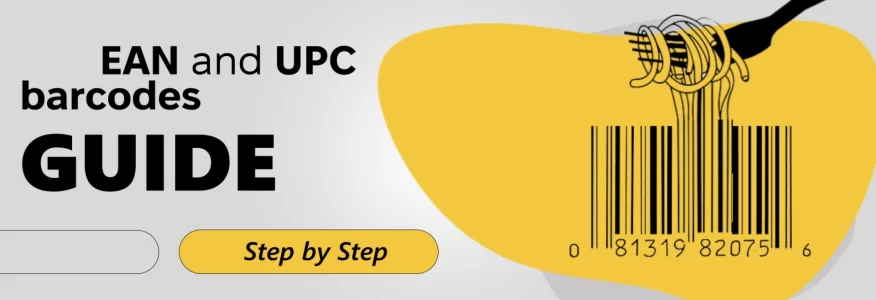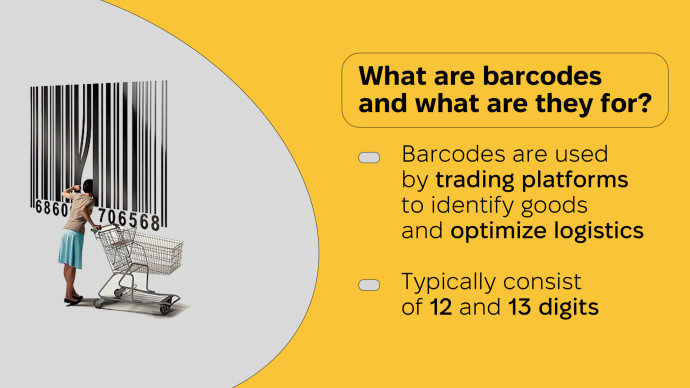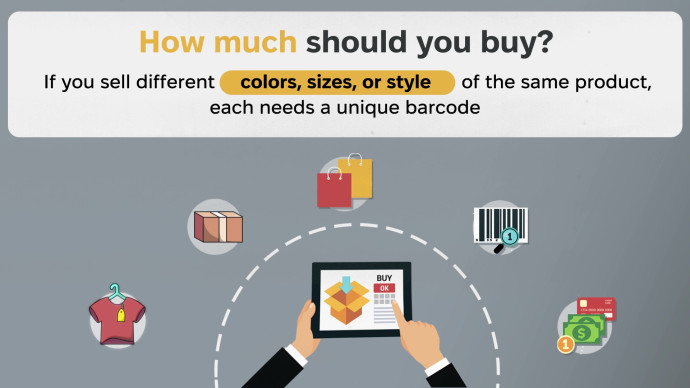
29.12.2023
12:18Guide About Barcodes - Everything You Must Know!
Barcodes are small black-and-white markings we've all seen on products, from food to medicine and electronics. These seemingly simple patterns are like magic wands for businesses, making transactions smoother and inventory management a breeze.
They're super useful when it comes to speedy checkouts, accurate pricing, and efficient stock tracking. For organizations, barcodes are a lifesaver as they enhance productivity, minimize errors, and streamline processes.
So, whether you're running an online store, a supermarket, or any other type of business that involves tracking inventory — barcodes can help. In this blog post, we'll explain everything about barcodes, their types, where you can buy them, their pricing, and much more.
So, without further ado, let's get started!
What are barcodes?
Barcodes are graphical representations of data that can be decoded and interpreted by machines. They are basically invented and upheld by GS1(Global Standard 1) and are used for business communication.
At their core, they are a bridge between the digital and physical worlds, which not only streamline communication of information, including product name, original price, and inventory number but also make it easier to identify and track items.
Barcodes can be rectangular or square in shape with series of parallel lines (bars) of varying widths and spacings that can be scanned by a special barcode scanner to quickly input data into a computer or other system.
What are they needed for?

To put it simply, every business that deals with products and inventory needs barcodes. By using barcodes, businesses can easily print product labels, keep track of each item on the shelves, and check in/check out items quickly at the checkout counter.
In retail, they speed up checkouts and manage inventory. In logistics, they track and trace shipments, ensuring timely deliveries. Besides, Healthcare uses them to match patients with their treatments, while libraries employ them for book management.
Types of barcodes
When it comes to barcodes, there are two types strutting their stuff.
1D (One-dimensional barcodes) — the classics
These are linear barcodes, meaning they represent data in a single line of varying widths and spacings. The data in these barcodes is typically alphanumeric.
- UPC Code (Universal Product Code): One of the most recognizable barcode labels around, the UPC code, or Universal Product Code, is primarily used in the US and Canada. UPC barcodes are standard for retail items. There are two main types of UPC code: UPC-A (12 digits) and UPC-E (a shortened version of UPC-A).
- EAN Code: If you've ever shopped outside of North America, you've probably come across the EAN code. It's the international counterpart to the UPC, used widely in Europe. EAN Code also has two primary types: EAN-13 (13 digits) and EAN-8 (8 digits).
- CODE 39: CODE 39 is a versatile code type known for its ability to encode data like numbers, uppercase letters, and several special characters. It's common in the automotive and defense sectors.
- CODE 128: This barcode is a high-density linear code. It's incredible for a complete barcode system due to its wide array of characters. With its ability to encode all 128 ASCII characters, it's often seen in packaging and shipping.
- ITF (Interleaved 2 of 5): This barcode is like a dynamic duo, a two-width wonder! It's the go-to choice for the warehousing and distribution industries, effortlessly representing pairs of numbers with style.
- CODE 93: Developed as an enhancement to CODE 39, CODE 93 offers a more compact encoding for the same character set.
Codabar: Often used in libraries and blood banks, Codabar can encode numbers and a few special characters. - GS1 DataBar: A more modern evolution, the GS1 DataBar can carry more information than the traditional UPC and is often seen on perishable goods.
2D Barcodes
Unlike linear barcodes, 2D barcodes can encode data in both vertical and horizontal directions.

- QR Code: It's among the most common types of 2D barcodes and is used mostly. You've likely scanned one of these with your smartphone! QR codes, or Quick Response codes, can store a lot of data, including website URLs. They've become ubiquitous in marketing, ticketing, and even in restaurants for digital menus.
- Data Matrix Code: Compact and reliable, data matrix codes can store large amounts of data, often seen in electronics, healthcare, and on small items due to their ability to be printed in tiny sizes.
- PDF417: Typically used on IDs and boarding passes, this barcode can hold over 1,000 characters, making it a powerhouse for data storage.
- Aztec: Commonly found on transportation tickets, the Aztec code can be scanned even without a quiet zone around it, making it quite efficient.
With the evolution of barcode scanners, scanning barcodes, whether they are UPC barcodes, data matrix codes, or any other barcode types, has become more efficient. A simple scan can quickly decode the data held within these compact designs.
When you need to buy a barcode, and when it is optional
Undeniably, barcodes have become the unsung heroes of the retail and logistics world, silently simplifying operations and making life easier for both consumers and businesses. But when do you actually need to get your hands on one?
Retail sales
If you're planning to sell your product in a retail environment, then a barcode is almost always a necessity. Major retailers require products to have a unique barcode, typically a Universal Product Code (UPC), to manage their inventory, set prices, and run their Point-of-sale systems efficiently.
Online marketplaces
Platforms like Amazon or eBay require barcodes for most products, especially if you want them to handle your storage and shipping (like with Fulfillment by Amazon). It helps them efficiently manage their vast warehouses and ensure customers receive the right products.
Track & manage inventory
Even if you're running a small business or a local store, barcodes can be indispensable. They help in quickly taking stock, reordering products, and preventing theft or loss.
When it is optional
On the flip side, there are times when barcoding isn't a hard and fast requirement, though they can still be useful.
Selling directly
If you're selling directly to customers from your workshop or studio or through local craft fairs, you might not need a barcode. Your scale and direct interaction allow you to manage without it.
Custom or One-Off Products
Items that are bespoke, such as art pieces or custom jewelry, usually don't require barcodes, as they aren't part of a standardized inventory system.
Digital products
If you're selling eBooks, downloadable software, or online courses, there's no physical product to attach a barcode to. Your digital distribution platform will manage inventory through other means.
Where to buy barcodes
When it comes to buying barcodes, the best route is through an authentic source. GS1, the global standards organization, is the primary and original issuer of barcodes. By purchasing directly from GS1, you ensure that your barcode is unique and registered to your company, giving you global legitimacy.
Well, we understand that purchasing UPS and EAN barcodes directly from GS1 often comes with an added cost. At the same time, it is true that your product is assigned to your company. But here comes the role of the reseller. If you purchase barcodes from the resellers, not only is your product assigned, but you'll also get barcodes at a much lower price than from GS1.
Plus, there is no annual fee, regardless of the package you choose. Moreover, you can obtain a single barcode for just $5, with the possibility of even greater discounts when purchasing barcodes in bulk. Furthermore, you will receive an instant receipt without the need for lengthy application processes.
http://www.barcodestock.com offer a legitimate barcode reselling service, so you don't have to wait, and you'll get barcodes at a cheaper price and easier way.
How Much Barcodes you need to purchase

Essentially, the number of barcodes you need largely depends on the breadth of products you may have and the distinctiveness of each variant.
Let's say you run a boutique candle-making business. You have three scents: Lavender, Rose, and Lemon. If you're only selling one size and packaging type for each scent, you'd need three barcodes – one for each scent. However, if you offer two sizes (small and large) for each scent, you'd then need six barcodes in total: one for small lavender, one for large lavender, and so on.
Here's the good news: You can purchase single GTINs for $30 with no renewal fee. If you have a small assortment and need ten or more barcodes, then you have to pay around $250 with a $50 annual renewal fee as per 2023 latest data.
Barcode printing: How to apply correctly
When it comes to printing barcodes for your Amazon listing, precision is key. You'll likely be using either UPC or EAN barcodes, which you should have purchased from a reputable source like GS1. Use high-quality label paper and a reliable thermal printer for optimal scanning performance.
Make sure the barcode is clear, not smudged, and easy to read. Placement is also key; the barcode should go on a flat, smooth surface of your product packaging. Don't place it over a seam or corner, as that could impede scanning. Once the barcode is printed and attached, test it with a barcode scanner to ensure it's functional. This step will save you a lot of headaches down the line.
Frequently Asked Questions (FAQs)
Barcode lookup. How can I check the barcode details?
To retrieve details from a barcode, you'll need an optical scanning device or laser scanners. These tools read the barcode's lines, decode the barcode symbology, and convert it into readable data. Plus, there are many mobile apps available that use your smartphone's camera to scan and interpret barcodes, providing instant details. Also you can check online (barcode lookup) here https://barcodestock.com/lookup.html
How does a barcode work?
Barcodes function as optical machine-readable representations of data. When a barcode is scanned by an optical scanning device, such as a laser scanner, the dark and light patterns are translated into binary data. This data is then interpreted based on the specific barcode symbology and converted into meaningful information.
What is the basic barcode format?
The basic barcode format consists of parallel lines with varying widths and spacings. These lines represent data encoded using specific barcode fonts and symbology. Surrounding these lines are quiet zones, which are essential for scanners to recognize the start and end of the barcode. The combination of these elements forms various barcode formats, which cater to different industry needs.
How many lines are in a barcode?
The number of lines in a barcode can vary based on the chosen barcode symbology and the data it contains. Generally, barcodes comprise several parallel lines. The density and the number of these lines depend on the specific data encoded and the barcode format used.
Conclusion — The bottom line!
All in all, barcodes are essential tools in the modern retail and logistics landscape. They streamline operations, facilitate inventory management, and are a requirement for selling on major retail platforms. By understanding the specifics of barcode usage, ensuring correct application, and knowing how to decipher barcode details, businesses can effectively utilize this technology to enhance their operations and customer service.